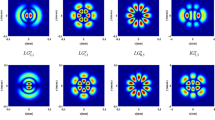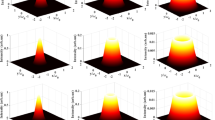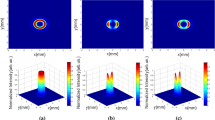Abstract
Tricomi beams are structured light beams that belong to the general class of non-diffracting light beams. The cross-section of an ideal Tricomi beam extends upto infinity and hence the energy distribution in the transverse plane (beam cross-section) is not finitely bounded. But all real-world systems are finitely bound, which causes inconvenience in studying Tricomi beams practically. To overcome this issue we introduce Tricomi–Gauss beam for the first time, which possesses similar characteristics to Tricomi beams but with a finite beam cross-section. In this study, we derive the general expression for the Tricomi–Gauss beam and its propagation. We show that the derived equation can be used to study the propagation properties of a family of Bessel–Gauss beams only by setting the appropriate parameters to the derived equation. Simulation results show the intensity and phase profiles of the beams as they propagate through (i) free space (ii) lens system and (iii) fractional Fourier transform system. Interesting propagation characteristics were observed, especially in the case of the asymmetric Bessel–Gauss beam, which can be attributed to the choice of parameters. The advantages of Tricomi–Gauss beam are verified by practically generating the beams using computer-generated holography technique.












Similar content being viewed by others
Availability of data and materials
The datasets generated during and/or analysed during the current study are available from the corresponding author on reasonable request.
References
Arrizón, V., Ruiz, U., Carrada, R., et al.: Pixelated phase computer holograms for the accurate encoding of scalar complex fields. J. Opt. Soc. Am. A 24(11), 3500–3507 (2007). https://doi.org/10.1364/JOSAA.24.003500
Bagini, V., Frezza, F., Santarsiero, M., et al.: Generalized Bessel–Gauss beams. J. Mod. Opt. 43(6), 1155–1166 (1996). https://doi.org/10.1080/09500349608232794
Bayraktar, M., Başdemir, H.D.: Cylindrical-sinc beam. Optik 125(19), 5869–5871 (2014). https://doi.org/10.1016/j.ijleo.2014.07.054
Belafhal, A., Ez-Zariy, L., Hennani, S., et al.: Theoretical introduction and generation method of a novel nondiffracting waves: Olver beams. Opt. Photonics J. 5(07), 234 (2015). https://doi.org/10.4236/opj.2015.57023
Cao, Z., Zhai, C., Xu, S., et al.: Propagation of on-axis and off-axis Bessel beams in a gradient-index medium. J. Opt. Soc. Am. A 35(2), 230–235 (2018). https://doi.org/10.1364/JOSAA.35.000230
Chafiq, A., Hricha, Z., Belafhal, A.: Paraxial propagation of Mathieu beams through an apertured ABCD optical system. Opt. Commun. 253(4), 223–230 (2005). https://doi.org/10.1016/j.optcom.2005.04.068
Collins, S.A.: Lens-system diffraction integral written in terms of matrix optics\(\ast \). J. Opt. Soc. Am. 60(9), 1168–1177 (1970). https://doi.org/10.1364/JOSA.60.001168
Durnin, J.: Exact solutions for nondiffracting beams. I. The scalar theory. J. Opt. Soc. Am. A 4(4), 651–654 (1987). https://doi.org/10.1364/JOSAA.4.000651
Durnin, J., Miceli, J.J., Eberly, J.H.: Diffraction-free beams. Phys. Rev. Lett. 58, 1499–1501 (1987). https://doi.org/10.1103/PhysRevLett.58.1499
El Halba, E., Boustimi, M., Ez-zariy, L., et al.: Propagation characteristics of Bessel-like beams through ABCD optical system. Opt. Quant. Electron. 49(8), 1–11 (2017). https://doi.org/10.1007/s11082-017-1099-z
Engelbrecht, C.J., Stelzer, E.H.: Resolution enhancement in a light-sheet-based microscope (SPIM). Opt. Lett. 31(10), 1477–1479 (2006). https://doi.org/10.1364/OL.31.001477
Eyyuboğlu, H.T., Bayraktar, M.: Propagation properties of cylindrical sinc Gaussian beam. J. Mod. Opt. 63(17), 1706–1712 (2016). https://doi.org/10.1080/09500340.2016.1170902
Forbes, A., de Oliveira, M., Dennis, M.R.: Structured light. Nat. Photonics 15(4), 253–262 (2021). https://doi.org/10.1038/s41566-021-00780-4
Garcés-Chávez, V., McGloin, D., Melville, H., et al.: Simultaneous micromanipulation in multiple planes using a self-reconstructing light beam. Nature 419(6903), 145–147 (2002). https://doi.org/10.1038/nature01007
Gerrard, A., Burch, J.M.: Introduction to Matrix Methods in Optics. Courier Corporation (1994)
Guizar-Sicairos, M., Gutiérrez-Vega, J.C.: Generalized Helmholtz–Gauss beam and its transformation by paraxial optical systems. Opt. Lett. 31(19), 2912–2914 (2006). https://doi.org/10.1364/OL.31.002912
Gutiérrez-Vega, J.C., Iturbe-Castillo, M.D., Chávez-Cerda, S.: Alternative formulation for invariant optical fields: Mathieu beams. Opt. Lett. 25(20), 1493–1495 (2000). https://doi.org/10.1364/OL.25.001493
Havelock, T.: Mathematical analysis of wave propagation in isotropic of p dimensions. Proc. Lond. Math. Soc. 2(1), 122–137 (1905)
Jackin, B., Palanisamy, P.: A completely open source based computing system for computer generation of Fourier holograms. Comput. Phys. Commun. 180(10), 1882–1887 (2009). https://doi.org/10.1016/j.cpc.2009.04.014
Kotlyar, V.V., Kovalev, A.A., Skidanov, R.V., et al.: Asymmetric Bessel Gauss beams. J. Opt. Soc. Am. A 31(9), 1977–1983 (2014a). https://doi.org/10.1364/JOSAA.31.001977
Kotlyar, V.V., Kovalev, A.A., Soifer, V.A.: Asymmetric Bessel modes. Opt. Lett. 39(8), 2395–2398 (2014b). https://doi.org/10.1364/OL.39.002395
Kotlyar, V.V., Stafeev, S.S., Porfirev, A.P.: Tight focusing of an asymmetric Bessel beam. Opt. Commun. 357, 45–51 (2015). https://doi.org/10.1016/j.optcom.2015.08.084
Kovalev, A.A., Kotlyar, V.V.: Lommel modes. Opt. Commun. 338, 117–122 (2015). https://doi.org/10.1016/j.optcom.2014.09.082
Liu, H., Hu, Z., Xia, J., et al.: Generation and applications of non-diffraction beam. Acta Phys Sinica (Ch Ed) 67(214), 204 (2018). https://doi.org/10.7498/aps.67.20181227
Lu, D.Q.: Generalized Tricomi and Hermite–Tricomi functions. Appl. Math. Comput. 218(9), 5090–5098 (2012). https://doi.org/10.1016/j.amc.2011.10.074
McLaren, M., Agnew, M., Leach, J., et al.: Entangled Bessel–Gaussian beams. Opt. Express 20(21), 23589–23597 (2012). https://doi.org/10.1364/OE.20.023589
Mphuthi, N., Gailele, L., Litvin, I., et al.: Free-space optical communication link with shape-invariant orbital angular momentum Bessel beams. Appl. Opt. 58(16), 4258–4264 (2019). https://doi.org/10.1364/AO.58.004258
Pei, S., Xu, S., Cui, F., et al.: Propagation of a Bessel–Gaussian beam in a gradient-index medium. Appl. Opt. 58(4), 920–926 (2019). https://doi.org/10.1364/AO.58.000920
Planchon, T.A., Gao, L., Milkie, D.E., et al.: Rapid three-dimensional isotropic imaging of living cells using Bessel beam plane illumination. Nat. Methods 8(5), 417–423 (2011). https://doi.org/10.1038/nmeth.1586
Santarsiero, M.: Propagation of generalized Bessel–Gauss beams through ABCD optical systems. Opt. Commun. 132(1), 1–7 (1996). https://doi.org/10.1016/0030-4018(96)00298-2
Singh, S.K., Haginaka, H., Jackin, B.J., et al.: Generation of Ince–Gaussian beams using Azocarbazole polymer CGH. J. Imaging 8(5), 144 (2022). https://doi.org/10.3390/jimaging8050144
Siviloglou, G.A., Christodoulides, D.N.: Accelerating finite energy airy beams. Opt. Lett. 32(8), 979–981 (2007). https://doi.org/10.1364/OL.32.000979
Sokolovskii, G.S., Dudelev, V.V., Losev, S.N., et al.: Optical trapping with Bessel beams generated from semiconductor lasers. J. Phys: Conf. Ser. 572(1), 012039 (2014). https://doi.org/10.1088/1742-6596/572/1/012039
Stoian, R., Bhuyan, M.K., Zhang, G., et al.: Ultrafast Bessel beams: advanced tools for laser materials processing. Adv. Opt. Technol. 7(3), 165–174 (2018). https://doi.org/10.1515/aot-2018-0009
Svelto, O., Hanna, D.C.: Principles of Lasers, vol. 4. Springer, Berlin (1998)
Whittaker, E.T.: On the partial differential equations of mathematical physics. Math. Ann. 57(3), 333–355 (1903). https://doi.org/10.1007/BF01444290
Wu, Q., Ren, Z.: Study of the nonparaxial propagation of asymmetric Bessel–Gauss beams by using virtual source method. Opt. Commun. 432, 8–12 (2019). https://doi.org/10.1016/j.optcom.2018.09.039
Zhu, J., Zhu, K., Ding, N., et al.: Tricomi beams and nondiffracting sheet beams. Results Phys. 28(104), 627 (2021). https://doi.org/10.1016/j.rinp.2021.104627
Acknowledgements
S.K.S. acknowledges the Ministry of Education, Sports, and Culture of Japan (MEXT) scholarship provided by the Japanese Government for his studies at the Kyoto Institute of Technology.
Funding
The authors declare that no funds, grants, or other support were received during the preparation of this manuscript.
Author information
Authors and Affiliations
Contributions
S.K.S and B.J.J conceived the idea, S.K.S did the simulations and experiments, K.K, N.T and W.S helped with the experiments and provided suggestions, S.K.S wrote the main manuscript B.J.J supervised the research. All authors reviewed the manuscript.
Corresponding authors
Ethics declarations
Competing interests
The authors have no competing interests as defined by Springer, or other interests that might be perceived to influence the results and/or discussion reported in this paper.
Ethical approval
Not applicable.
Additional information
Publisher's Note
Springer Nature remains neutral with regard to jurisdictional claims in published maps and institutional affiliations.
Rights and permissions
Springer Nature or its licensor (e.g. a society or other partner) holds exclusive rights to this article under a publishing agreement with the author(s) or other rightsholder(s); author self-archiving of the accepted manuscript version of this article is solely governed by the terms of such publishing agreement and applicable law.
About this article
Cite this article
Singh, S.K., Kinashi, K., Tsutsumi, N. et al. Tricomi–Gauss beam and its propagation characteristics. Opt Quant Electron 55, 352 (2023). https://doi.org/10.1007/s11082-023-04626-x
Received:
Accepted:
Published:
DOI: https://doi.org/10.1007/s11082-023-04626-x




